Tales of an East Street Boy: Jim Mackenzie – Charlton Athletic Pioneer
08/08/2019 - 11.41
Stephen Hunnisett
Although I’ve become slightly disconnected with Charlton Athletic in recent years it is still very much my local club and despite watching more non-league football in recent times, I continue to attend matches at The Valley regularly, as I have since the late 1970s. Despite this, I must confess that I wasn’t particularly aware of the name of Jim Mackenzie until more recently. In fact, it wasn’t until I saw his name on the plaque containing the names of the club’s First World War Roll of Honour and the name of the ship on which he served that I became more conscious as to exactly who Jim was and just how significant a figure he was in the birth and formative years of this great football club.
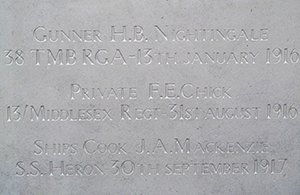
[CAFC Memorial Names, Jim MacKenzie's name at the bottom – Author’s Photo]
I was especially drawn to Jim’s story because like me, he had served in the Merchant Navy and by a strange coincidence, for a constituent company of my old employer, the Peninsular & Oriental Steam Navigation Company, perhaps better known as the P&O.

[Jim Mackenzie (in bow tie) – Charlton Athletic Museum]
It might sound strange to describe someone who was fifteen years old at the time of the club’s formation as a “Founding Father” but that is exactly what Jim was, for without him to handle the administration of the fledgling football club, including arranging the fixtures, it could be argued that Charlton Athletic wouldn’t have become established at all. John Alexander Mackenzie, as you might have guessed, was a Scot, born in 1890 in Dundee to parents William and Annie Mackenzie. The 1891 Census tells us that William was a Draper’s Cashier whilst Annie stayed at home to look after Jim (as he seems to have been universally known) and his four younger siblings – three sisters and a brother.
For reasons now unknown, by the time of the 1901 Census being taken, the Mackenzie family had uprooted south to London, where William Mackenzie had taken a job as a Dockyard Labourer and had settled at 36 Cedar Grove in Charlton. As part of a general street renaming in the area, Cedar Grove was later to be renamed Floyd Road. So it would appear that even at this early stage of his life, Jim was to be inextricably linked with Charlton Athletic’s future history, even though the idea of a football ground being built here was yet to be mooted and he would not live to see his team play here. Incidentally, if the numbering system of Cedar Grove was perpetuated when it was renamed, the site of the Mackenzie family’s former house is now The Seabay Fish Bar, much beloved of Addicks’ supporters!
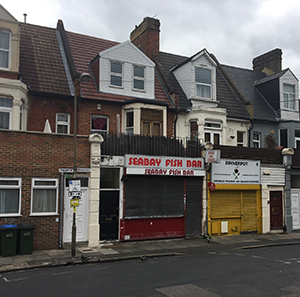
[Seabay Fish Bar (Mackenzie family’s first home in Charlton) – Author’s Photo]
The family relocated in early 1905 to 5 York Street – now renamed Mirfield Street – which runs between East and West Streets (now Eastmoor and Westmoor Streets) – the very heart of the catchment area for the embryonic Charlton Athletic FC. Jim was to be the very first Honorary Secretary for the club and it was his name which appeared in the advertisement on the “Junior Football” page in the Kentish Independent on 27 October 1905, as the person to contact for potential opposition clubs looking for a fixture. This small and seemingly insignificant advert represents the first time ever that the name of Charlton Athletic would appear in the printed news media.

[Kentish Independent 27 October 1905 – Author’s Collection]
Jim must have been an efficient Honorary Secretary, as the club became established in the local junior leagues but by November 1908, he had turned eighteen and perhaps looking to see the world, decided to enlist in the Merchant Navy. He joined a Deptford based company, the General Steam Navigation Company, known more affectionately as “The Navvies” which was at the time Britain’s premier coastal and short-sea shipping company, engaged in trades to Europe and the Mediterranean, as well as operating excursion steamers on the Thames. Perhaps it was the relatively short voyages made by the company’s vessels that attracted him, as this would allow him to watch at least the occasional Charlton match when voyage schedules permitted. The GSN was founded in 1824 and was the oldest shipping company in the world to begin business using steamships, as well as the first steamship company to carry a reigning British monarch on one of its vessels. Despite this illustrious record, they were a notoriously unsentimental company when it came to recording their past. Because of this, they are a difficult company to research; as Stephen Rabson, the P&O Group historian and archivist once wrote “The GSN archive…is disappointingly small for a company which lasted so long.”
The 1911 Census found Jim serving on board the Steamship Heron, berthed alongside at Weaver’s Wharf, North Dock, Swansea. This vessel was employed on the run to Oporto in Portugal, carrying coal and general cargo. His rank at that time was described as “Mess Room Steward”. The Heron was an iron-built steamship of 887 grt built in 1889 by Gourlay Brothers in Dundee and was an elderly vessel, which had it not been for the outbreak of war in 1914, would most likely have been scrapped and replaced by newer tonnage. By 1915, Jim had been promoted to Ship’s Cook and by this time, perhaps bolstered by his regular wages supplementing his father’s pay, the family had moved to 57 Delafield Road in Charlton, once again a stone’s throw from the future home of the football club that Jim had been instrumental in founding. It was commonplace in those days for Merchant Navy captains to keep together a regular and trusted crew, so it must be assumed that Jim was not only a decent ship’s cook but was also trustworthy and well-liked by his crewmates.
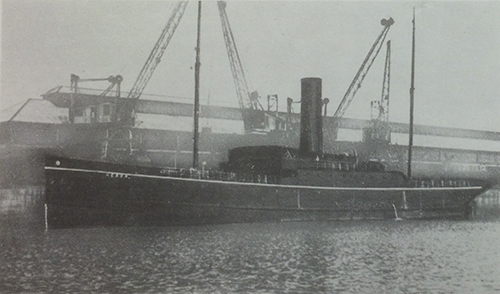
[S.S. Heron – P&O Heritage Collection]
Of course, by the time of this latest family relocation, the Country was at war with Germany and the Merchant Navy was heavily involved, taking its traditional dual role of keeping the country supplied with foodstuffs and raw materials, as well as supporting the armed forces logistically. A new and fearsome weapon, in the form of the submarine had come to prominence in the years leading up to the war and although the British had initially condemned them in the words of Admiral Sir Arthur Wilson as “Underhand, unfair and damned un-English” they had quickly become integral parts of the navies of the combatant nations in the war. However, the Imperial German Navy had embraced the technology from the outset and on 22 September 1914, the U-9 commanded by Otto Weddigen made an immediate impact by sinking three obsolete British cruisers, Aboukir, Hogue and Cressy in the Irish Sea, with heavy loss of life. The British press immediately compared German submariners unfavourably to pirates but this was an early taste of legitimate submarine warfare but following the sinking of the liner Lusitania the following year with the loss of many American civilian passengers, the Germans had withdrawn the submarine fleet from commerce raiding for fear of drawing the USA into the war and was given strict instructions to attack Allied warships only.
However, in January 1917, the British blockade of Germany was beginning to have a disastrous effect on food supplies and as a result, the Kaiser lifted the restrictions on the German submarine fleet and all merchant ships were once again fair game. As a result, the British instigated a convoy system which initially covered just the supply routes across the Channel and the North Sea but which was quickly extended to cover the Transatlantic and Mediterranean routes as well. Merchant Navy Masters and crews had to adapt to a new method of loading around the British coast and then proceeding to a rendezvous point where the convoy would form and meet with the naval escort.
On 27 September 1917, the Heron was at Falmouth having loaded a typical cargo of coal in Newcastle and general cargo in London bound for her traditional peacetime destination of Oporto. The convoy sailed at 16:00 on the same day and was escorted by nine destroyers of the 4th Destroyer Flotilla under the command of the Senior Officer, Commander Francis Twigg RN in the destroyer HMS Lysander.
There was another GSN vessel in the convoy, the Drake, commanded by Captain Carter but on the night of 30 September, whilst crossing the Bay of Biscay, she was sunk by the gunfire of submarine U-90, commanded by Kapitanleutnant Walter Remy. This was a new submarine that had only been commissioned in August 1917, which was armed with six 50 cm torpedo tubes (with sixteen reloads) and also had a 10.5 cm gun for surface attacks on shipping. Remy was an experienced commander, who had previously commanded U-24 and was already responsible for sinking 31,000 tons of Allied shipping. Thus, after sinking the Drake and realising that the escort would now be searching for him on what was a bright moonlight night, he decided to dive his submarine to evade detection. About two hours later, he spotted Heron and fired a torpedo at close range. The impact of a heavyweight torpedo against the elderly iron-hulled coaster was devastating and she sank like a stone. The engine room crew and anyone below decks would not have stood a chance. The only survivor was a Japanese crane operator, named Higo, who had been off duty and taking a bath when the torpedo struck. He immediately jumped out of his bath, ran out of his cabin and straight over the side of the stricken vessel.
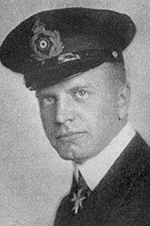
[Kapitanleutnant Walter Remy – Author’s Collection]
Higo later recalled that despite the bright moonlight, he could not see any other survivors, although he could hear cries for help in the water. He was picked up by the U-Boat a few hours later and was soon joined by Captain Carter of the Drake, who was also rescued as was often the case with Masters and Chief Engineers as a method of taking these experienced mariners out of the war and also as a means of trying to ascertain details about the convoy. The entire crew of the Drake were rescued by other ships of the convoy but of the Heron and her remaining crew, including Jim Mackenzie, there was no trace and today they rest at position 46⁰ 27’ N, 11⁰ 14’ W, some 300 miles southwest of Ushant, in the Bay of Biscay.
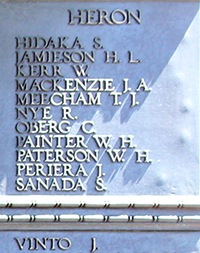
[J.A. Mackenzie on the Merchant Navy Memorial at Tower Hill – CWGC Photo]
Jim Mackenzie was an administrator rather than a player but without his diligent work during the formative years of the club, it is arguable whether the name of Charlton Athletic would have become established as a force in the footballing world. It is right that his name sits proudly alongside Fred Chick and Nobby Nightingale on the club’s First World War Roll of Honour.
Published Sources
Birds of the Sea; 150 Years of the General Steam Navigation Company – Nick Robins, published by Bernard McCall, 2007
The Story of Charlton Athletic 1905-1990 – Richard Redden, published by Breedon Books, 1990
Unpublished Sources
UK National Archives, Kew – ADM 137/2628 – Admiralty Historical Section: Records used for Official History, First World War Convoy Records, Outward Convoys Falmouth OF1 – OF21
P&O SN Co Archives held at National Maritime Museum, Greenwich – GSN/1/43 – Minutes of the GSN Company, October 1917
P&O SN Co Archives held at National Maritime Museum, Greenwich – GSN/41/24 – GSN Newsletter issue 93
National Maritime Museum Archives, Greenwich – RSS/CL/1915/3444/12 – S.S. Heron crew list 1915
Biography

Steve is now a full time Battlefield Guide, military history blogger and researcher, specialising in the Home Front and London at war in particular, who took the plunge into self-employment in 2015. He is a Southeast London boy by birth and splits his football watching time between Charlton Athletic and Dulwich Hamlet FC, being a season ticket holder at both clubs. He has developed a great interest in the history and heritage of both these community-oriented clubs and is the author of ‘For Freedom’, which tells the story of Dulwich Hamlet’s Second World War casualties.


/prod01/wlvacuk/media/departments/digital-content-and-communications/images-2024/240624-Alumni-Awards-2024-Resized.jpg)
/prod01/wlvacuk/media/departments/digital-content-and-communications/images-18-19/220325-Engineers_teach_thumbail.jpg)
/prod01/wlvacuk/media/departments/digital-content-and-communications/images-2024/240627-UN-Speaker-Resized.jpg)
/prod01/wlvacuk/media/departments/digital-content-and-communications/images-2024/240320-Uzbekistan-Resized.jpg)
/prod01/wlvacuk/media/departments/digital-content-and-communications/images-2024/240229-The-Link-Resized.jpg)
/prod01/wlvacuk/media/departments/digital-content-and-communications/images-2024/240627-Lady-Aruna-Building-Naming-Resized.jpg)